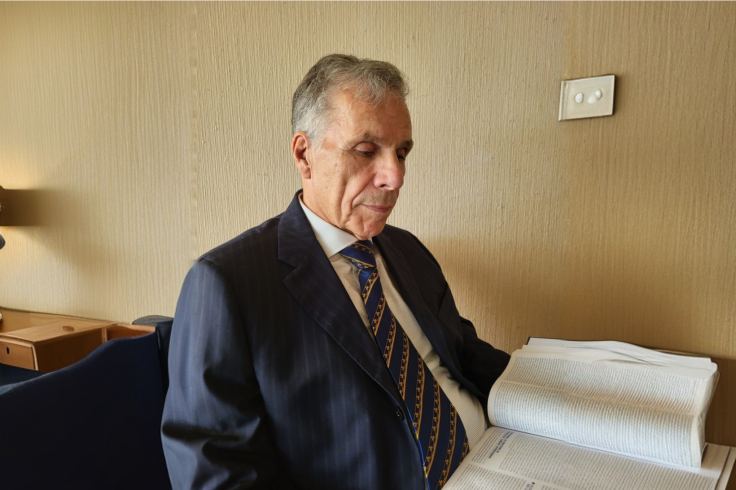Dr. Klaus Rentrop Shares Acute Myocardial Infarction: Part 4

Dr. Klaus Rentrop describes how three scientific errors withheld lifesaving treatments for heart attacks from patients for 30 years.
In 1880, Dr Karl Weigert, a German pathologist, described the cause of heart attacks: A blood clot (thrombus) forms in one of the heart's arteries at a spot already narrowed by atherosclerosis. Complete occlusion of the vessel abruptly stops blood flow to part of the heart muscle, which then dies. Dr James Herrick familiarized American physicians with this insight 30 years later. Further research revealed that clot formation is triggered by the breakage of the atherosclerotic narrowing, called "plaque rupture."
Physicians hoped that the damaged heart muscle would heal during a period of prolonged bed rest of up to six weeks, the cornerstone of treatment for half a century. However, approximately 30% of patients died in the hospital from fatal irregularities of the heartbeat or from extensive heart muscle loss.
Streptococcus, a bacterium, can dissolve blood clots in a process called thrombolysis. This discovery by Dr William Tillett in 1933 led to the development of "streptokinase", the first thrombolytic medication. Dr Saul Sherry's group believed that streptokinase could save the lives of infarct patients by "the rapid dissolution of a coronary thrombus." Blood flow to the heart would be restored and limit muscle death, they hypothesized.
Their small pilot trial, published in 1958, was promising. Blood flow was reestablished as certain chemicals in the blood indicated. Hospital mortality was 15% among patients treated within 14 hours of symptom onset, compared with 30% among those treated later. However, Sherry, a hematologist, could not evaluate thrombolysis in a larger trial because, as he stated, "Cardiologists no longer stressed coronary thrombosis as the cause of acute infarct."
In the late 1950s, pathologists reported that blood clots were rare among victims of heart attacks and suggested that these clots had developed after the infarct. However, they always found extensive coronary atherosclerosis. They proposed that diminished blood flow without complete occlusion could cause infarction. In this view, clots developed only when a large infarct compromised the circulation, rendering blood flow in a severely narrowed artery sluggish.
Some pathologists disagreed with this view, but cardiologists adopted it during the 1960s. They considered the dissolution of blood clots, which had not caused the heart attack, to be futile. This first error derailed the development of life saving thrombolytic therapy.
Important progress in the treatment of heart attacks did occur, however, in 1962 with the introduction of coronary care units. Immediate recognition of fatal irregularities of the heartbeat by trained personnel and treatment with the recently developed defibrillators or pacemakers reduced infarct mortality by half. The still high in-hospital mortality of 15% resulted from the insufficient pump function of severely damaged hearts.
Animal studies published by Dr Eugene Braunwald in 1969 suggested that the extent of heart muscle death could be limited pharmacologically, without restoring blood flow. This was the second error. It dominated research throughout the 1970s. Approximately 50 "anti infarct drugs" were reported to limit infarct size in experimental animals by either reducing the heart's oxygen demand, preventing the accumulation of damaging substances, or providing energy independent of oxygen supply. Clinical pilot studies were promising. However, in the mid-1980s better designed trials refuted the initial positive findings.
Dr. Schaper proved that even when metabolism is reduced, cells in the infarct zone will inevitably overspend energy and die unless blood flow is restored. No agent ever achieved approval as an anti-infarct drug.
The young, inquisitive Dr. Francis Everhart was one of the few cardiologists to question the view that clots are not the cause of heart attacks. He became familiar with the discussions among pathologists during a one-year pathology fellowship in St. Paul, MN, in 1967/68, after completing his cardiology fellowship. He continued to participate in autopsies when he surgical group of Drs. Berg and Kendall in Spokane, WA, hired him in August 1968, and when he opened his own practice in March 1969. Eventually, he concluded that clots do cause heart attacks, and that only early restoration of blood flow could limit infarct size. Berg's successful bypass operations in pre-infarction patients convinced him that surgical revascularization could achieve this goal.
However, A coronary angiogram would be required before bypass surgery. Acute coronary angiography would also reveal the prevalence of total coronary occlusion at the beginning of heart attacks, settling the issue of contention among pathologists. Everhart's concept was radical at a time when bed rest was still the cornerstone of treatment, acute invasive procedures were considered harmful, and anti-infarct drugs excited cardiologists.
Everhart presented his vision to Berg at a meeting in mid-June of 1970. The concept made sense to Berg, who drew saw parallels to the occlusion of the leg artery by a blood clot, which required rapid surgical revascularization to avoid amputation. He agreed to consult for emergency bypass surgery on infarct patients under one condition: They would scientifically document and publish their work. In March of 1971, Dr Kendall performed the first emergency vein graft surgery for an acute myocardial infarction in Spokane. When he opened the coronary artery to attach the vein graft, a fresh clot "popped out", spectacularly confirming that blood clots occlude the infarct artery at the beginning of a heart attack.
The patient did extremely well. Heart function had returned to normal at the repeat angiography some weeks later. At the next hospital case conference, physicians were excited to hear about the retrieval of the blood clot and the immediate improvement in the patient's condition. Within a few years, surgical treatment of heart attacks became the standard of care in Spokane. But everywhere else in the US, revascularization was considered harmful. Bleeding into dead heart muscle that had been reported in experimental animals after restoration of flow was believed to extend damage. The third error had taken root.
Among pathologists, consensus about the frequency of coronary clots in heart attacks remained elusive at the Workshop organized by the National Institute of Health in 1973. The workshop concluded that the significance of coronary clots "must depend on the evidence that the thrombus either precedes infarction as a primary lesion or follows infarction as a secondary effect" and suggested further study.
Evidence accumulating in Spokane provided answers. Coronary angiography during evolving infarction revealed a total occlusion of the infarct-related artery in 81% of 118 patients. Surgeons encountered clots upon opening the infarct artery in one third of their cases and retrieved them. Furthermore, revascularization was not harmful; it improved heart function. Hospital mortality was 5.6% among 71 operated patients compared with 21% among medically treated patients.
Everhart presented these data at the World Congress of Cardiology in Buenos Aires, Argentina, in September 1974, and at the American College of Angiology meeting in San Juan, Puerto Rico, in February 1975.
His abstract "Revascularization Surgery for Acute Myocardial Damage" was printed in a 1974 Supplement to Circulation. However, the audience of physicians reacted negatively to the novel findings, which should have corrected scientific errors dominating research and impeding clinical treatment. Everhart was called a fool. He submitted yearly abstracts to the national American cardiology meetings. None was accepted. Everhart left Spokane at the end of 1977.
Berg focused his presentation at the Annual Meeting of the American Association for Thoracic Surgery in April 1975 on the reduction of infarct mortality achieved with bypass surgery. Dr. Eldred Mundth from Boston, concerned about infarct extension, warned against the Spokane approach.
However, Berg's presentation, published as a paper, created international interest. Dr. Phillips' group in Des Moines, Iowa, replicated the mortality results of the Spokane group in 75 patients. Their 1979 Circulation paper confirmed the high prevalence of total occlusion of the infarct artery and reported intraoperative clot retrieval in nearly all cases. The accompanying editorial to this paper, however, disregarded the important angiographic findings and clot retrieval.
It suggested that the low mortality was due to selection of low risk patients, although 16 of them were unable to maintain normal blood pressure prior to surgery! The tenaciousness of errors blinding cardiologists to mounting scientific evidence was remarkable, Peter Rentrop notes.



























